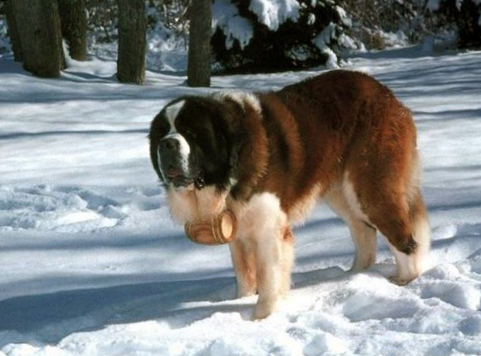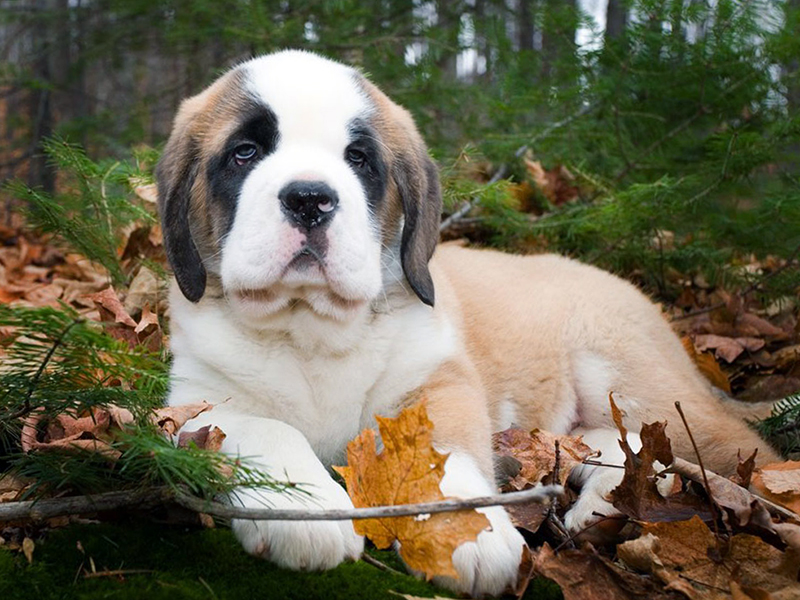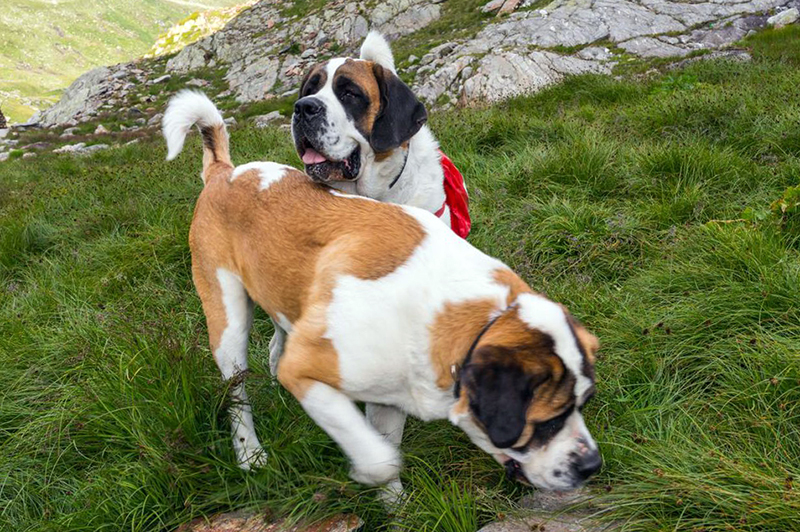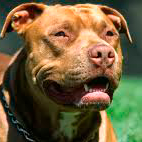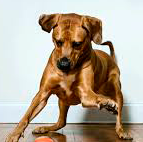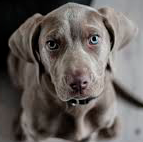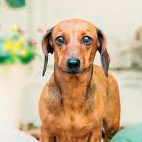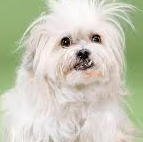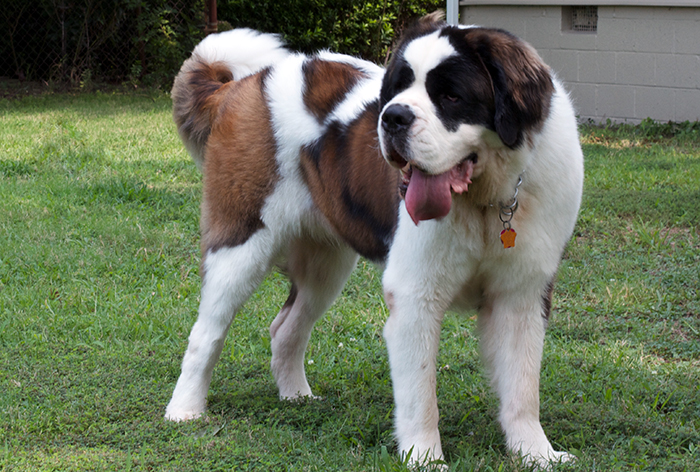
Saint Bernard Dog
Saint Bernard Dog pictures ➜
ORIGIN: Switzerland
UTILISATION: Companion-, watch and farm dog.
BRIEF HISTORICAL SURVEY: At the height of the Great St. Bernard Pass, 2469m (8100ft.) above sea level, a hospice was founded by monks in the 11th century as a refuge for travellers and pilgrims, and large mountain dogs have been kept there for watch and protection since the middle of the 17th century. The existence of such dogs has been documented in paintings and drawings dating back to 1695 and in written official documents of the Hospice since 1707.
These dogs were soon in service as companion dogs for the monks, being especially deployed as rescue dogs for travellers lost in snow and fog. Numerous chronicles, published in many languages, as well as verbal reports by the soldiers of Napoleon who transited the Great Pass with him in 1800, tell of many lives saved by these dogs in the face of “the White Death”. The fame of the St.Bernard, then known as the “Barry-dog”, spread throughout Europe in the 19th century, and the legendary dog “Barry” became the epitome of the rescue dog.
The direct ancestors of the St.Bernard were the large farm dogs which were widely spread across the region, and within a few generations after the establishment of the ideal type, they were bred into the present day breed. Heinrich Schumacher, from Holligen near Berne, Switzerland, was the first to document and provide pedigrees for his dogs. In February 1884 the “Schweizerische Hundestammbuch der SKG”(SHSB), the Swiss SKG/FCI Dog Stud Book, was opened. The very first entry was the St. Bernard “Léon”, and the following 28 entries were also all St. Bernards. The Swiss St. Bernard Club was founded in Basle on March 15th 1884. During the International Canine Congress of June 2nd 1887, the St. Bernard was officially recognised as a Swiss breed and the breed standard was declared as binding. Since that time the St. Bernard has been a Swiss national dog.
GENERAL APPEARANCE:
There are two varieties of the St. Bernard:
– Short-hair variety (Stockhaar, smooth coat)
– Long-hair variety (rough coat)
Both varieties are of notable size and have a balanced, sturdy, muscular body with imposing head and alert facial expression.
BEHAVIOUR-TEMPERAMENT: Friendly by nature. Temperament calm to lively, watchful.
IMPORTANT PROPORTIONS: Ideal proportion for height at withers to body length (measured from the point of the shoulder to the point of the ischium) = 5:6.
For the ideal relationship of height at withers to depth of chest see the following sketch.
HEAD
General: Massive and imposing
CRANIAL REGION: Skull strong, broad, seen in profile and from the front slightly rounded; sideways it merges gently rounded into the strongly developed high cheek bones, falling away steeply towards the muzzle. Occipital bone only moderately pronounced. Supraorbital ridges strongly developed. The frontal furrow, which starts as the root of the muzzle and runs over the whole skull, disappears towards the base of the occiput. The skin of the forehead forms wrinkles over the eyes which converge towards the frontal furrow. When the dog is attentive, the wrinkles become more pronounced. When alert, the set-on of the ear and the topline of the skull appear in a straight line.
Stop: Markedly pronounced.
FACIAL REGION:
Muzzle: Short, does not taper. Nasal bridge straight, with a shallow furrow running its length. Length of muzzle shorter than its depth, measured at the root of the muzzle.
Nose: Black, broad and square. Nostrils well opened.
Lips: Edge of lips black. Flews of upper jaw strongly developed, pendulous, forming a wide curve towards the nose. Corner of mouth remains visible.
Teeth: Strong, regular and complete scissor or even bite. Reverse scissor bite acceptable. Missing PM 1 (premolar 1) tolerated.
Eyes: Medium size. Colour dark brown to lighter nut-brown. Not too deeply set, with a friendly expression. Eyelids as close fitting as possible. Complete pigmentation on eye rims. Natural tightness of lids desired. A small angular wrinkle of the lower eyelid with inconspicuous showing of the conjunctiva, as well as a small angular wrinkle of the upper eye lid are allowed.
Ears: Medium size, set on high and wide. Strongly developed burr at the base. Ear flaps pliable, triangular with the tip rounded off. The back edge stands off slightly, the front edge lies close fitting to the cheeks.
NECK: Strong, dewlap not too exaggerated.
BODY
General: General appearance imposing and balanced.
Topline: Withers well defined. Straight from withers to loin. Rump falls away gently and merges with root of tail.
Back: Broad, strong and firm.
Chest: Brisket moderately deep with well sprung ribs, but not reaching beyond the elbows.
Belly and lower line: Slight tuck-up towards rear.
Tail: Set on broad and strong. Tail long and heavy, its last vertebra reaching at least to the hocks. When in repose, the tail hangs straight down or may turn gently upward in the lower third. When animated, it is carried higher.
LIMBS
FOREQUARTERS:
General: Stance rather broad, straight and parallel when seen from front.
Shoulders: Muscular, shoulder-blade oblique, well attached to the chest wall.
Upper arm: The same length or only slightly shorter than the shoulder-blade. Angle between shoulder blade and upper arm not too straight.
Elbow: Laying well onto the body.
Forearm: Straight, heavy boned, tautly muscled.
Pasterns: Vertically straight when seen from front and at a light angle when seen from the side.
Forefeet: Broad, compact, with strong, well arched toes.
HINDQUARTERS:
General: Hindquarters muscular with moderate angulation. Seen from rear, the hind legs are parallel and not too close together.
Upper thigh: Strong, muscular with broad buttocks.
Stifle: Well angulated, turning neither in nor out.
Lower thigh: Slanting and rather long.
Hock joints: Slightly angulated and firm.
Hock: Straight and parallel when seen from behind.
Hind feet: Broad, compact, with strong well arched toes. Dewclaws tolerated as long as they do not hinder movement.
GAIT: Co-ordinated, smooth reaching strides with good drive from the hindquarters. Hindquarters track in line with the forequarters.
COAT
HAIR:
Short-hair variety (Stockhaar, smooth coat): Top coat dense, smooth, close lying and coarse, with rich undercoat. Buttocks lightly breached. Tail covered with dense fur.
Long-hair variety (rough coat): Top coat plain, of medium length with a rich undercoat. Over the haunches and rump usually somewhat wavy. Front legs feathered. Buttocks well breached. Short hair on face and ears. Bushy tail.
COLOUR: Basic colour white with either small or large reddish-brown splashes (“splash coat”) or a continuous reddish-brown blanket covering back and flanks (“mantle coat”). A torn reddish-brown mantle (broken up by white) is of equal value. Reddish-brown brindle permissible. Brownish-yellow tolerated. Dark brown shadings on head desirable. Slight black shadings on body tolerated.
Markings: Chest, feet, tip of tail, muzzle band, blaze and patch on neck must be white.
Desirable: White collar.
Symmetrical dark mask.
SIZE: Minimal height: dogs 70 cm (27.56 in)
bitches 65 cm (25.59 in)
Maximum height: dogs 90 cm (35.43 in)
bitches 80 cm (31.5 in)
Dogs which exceed the maximum height will not be penalised, provided their general appearance is balanced and their movement correct.
FAULTS: Every departure from the foregoing points should be considered a fault which will be assessed according to the degree of departure from the standard.
– Lack of correct gender characteristics
– Unbalanced general appearance
– Strong wrinkles on head, excessive dewlap
– Muzzle too short or too long.
– Flews of the lower jaw turning outward
– Under- or overshot bite
– Missing teeth other than PM 1 (premolar 1)
– Low set on ears
– Light eyes
– Entropion, ectropion
– Eyelids too loose
– Sway back or roach back
– Rump higher than withers or falling away steeply
– Tail carried curled over back
– Crooked or severely turned out front legs.
– Poorly angulated, bowed or cow-hocked hindquarters
– Faulty movement
– Curly coat
– Incomplete or totally absent pigment on nose, around the nose, on lips and eyelids
– Faulty markings, e.g. white with reddish-brown ticks
– Faults of temperament: aggressiveness, shyness
DISQUALIFYING FAULTS:
– Coat totally white or totally reddish-brown
– Coat of a different colour
– Wall eye, blue eye.
N.B.: Male animals should have two apparently normally developed testicles fully descended into the scrotum.


